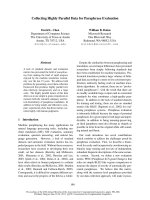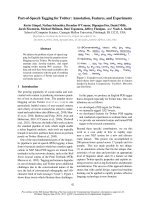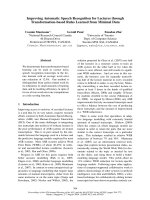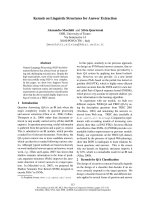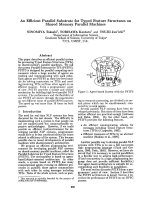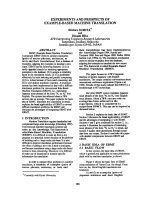Báo cáo khoa học: "Experiments on Candidate Data for Collocation Extraction" pot
Bạn đang xem bản rút gọn của tài liệu. Xem và tải ngay bản đầy đủ của tài liệu tại đây (202.87 KB, 4 trang )
Experiments on Candidate Data for Collocation Extraction
Stefan Evert and Hannah Kermes
Institut fiir Maschinelle Sprachverarbeitung
Universitat Stuttgart
{evert,kermes}@ims.uni
-
stuttgart.de
Abstract
The paper describes ongoing work on
the evaluation of methods for extract-
ing collocation candidates from large
text corpora. Our research is based
on a German treebank corpus used as
gold standard. Results are available
for adjective+noun pairs, which proved
to be a comparatively easy extraction
task. We plan to extend the evalua-
tion to other types of collocations (e.g.,
PP+verb pairs).
1 Introduction
While a mostly British tradition based on the
ideas of J. R. Firth defines collocations as (sig-
nificantly) frequent combinations of words cooc-
curring within a given text span, applications in
terminology, lexicography, and natural language
processing prefer a more restricted view. Collo-
cations are understood as unpredictable combina-
tions of words in a particular (morpho-)syntactic
relation
(adjectives modifying nouns, direct ob-
jects of verbs, or English noun-noun compounds).
The extraction of such collocations from text cor-
pora is usually performed in a three-stage process
(cf. Krenn (2000, 28-32) and references therein):
1. The source corpus is annotated with vary-
ing amounts of linguistic information (rang-
ing from part-of-speech tags to full parse
trees), depending on the tools available. Then
a list of word pairs satisfying the required
(morpho-)syntactic constraints is extracted
(typically based on part-of-speech patterns).
This first candidate list will contain both col-
locational and non-collocational pairs.
2.
Linguistic and/or heuristic filters may be ap-
plied to reduce the size of the candidate set.
For instance, certain "generic" adjectives as
well as those derived from verb participles
are rarely found in adj+noun collocations.
3.
The remaining candidates are ranked by sta-
tistical measures based on their frequency
"profiles". Usually, word pairs are consid-
ered likely to be collocations if their cooccur-
rence frequency is much higher than expected
by chance.
Authors typically evaluate the performance of a
single collocation extraction system as a whole
(e.g. Smadj a (1993)). A small number of in-depth
comparative evaluations (mostly Daille (1994)
and Krenn (2000)) concentrate on the quality of
the statistical measures and the corresponding
ranking of the candidates, and to a lesser extent
on the performance of linguistic filters. Although
Evert and Krenn (2001) are aware of the influence
that the first extraction step has on their results,
they fail to give a quantitative evaluation of differ-
ent pre-processing and extraction methods.
Our research aims to fill this gap. Currently, we
are evaluating methods for the extraction of adjec-
tive+noun pairs from German newspaper text. It is
planned to extend our work to other types of collo-
cations, including PP+verb and noun+verb pairs.
83
2 Evaluation procedure
With a collocation definition that is not based
purely on observed frequencies, the statistical
ranking of candidates has to be evaluated against
a manually confirmed list of true positives (cf.
Daille (1994) and Krenn (2000)). This methodol-
ogy is of little use for the evaluation of the candi-
date extraction step, though, for several reasons:
•
The accuracy of the extraction step influences
the final results in two quite different ways:
(a) by changing the set of candidate types; (b)
by changing their frequency profiles.
•
The influence of changes in the frequency
profiles depends crucially on the particular
statistical measure applied in the third stage.
•
In many cases, different extraction meth-
ods will produce only minor changes in the
set of candidates, especially when frequency
thresholds are applied. These subtle effects
will be masked by the much greater impact
of the statistical ranking
•
Simple extraction methods may find many
spurious candidates which do not satisfy
the required (morpho-)syntactic constraints.
Even though some of those might be true pos-
itives per se (i.e. they are accepted as collo-
cations by a human annotator), they are not a
part of the source corpus and thus should not
be included in the list of candidates.
Hence, it is necessary to evaluate the extraction
step independently, and to find an appropriate def-
inition of the expected goal
of the first processing
stage,
i.e. what results should ideally be produced.
Clearly, one cannot expect the extraction step
to distinguish collocations from non-collocations
without access to frequency information. The fre-
quency profiles of candidates should accurately re-
port the number of co-occurrences in the source
corpus, and spurious matches should be avoided.
This leads to the following evaluation goal:
Find all instances of word pairs that oc-
cur in a specific (morpho-)syntactic re-
lationship in the source corpus.
As a consequence, our evaluation is based on in-
stances of candidate pairs, i.e.
tokens rather than
types.
In our terminology, a
pair type
is a combi-
nation of two words, and the corresponding
pair
tokens
are the individual occurrences of this word
pair at specific positions in the corpus. Statistical
ranking methods are usually applied to and evalu-
ated on pair types.
The experiments reported here investigate the
extraction of German adjective+noun pairs, where
the noun is the head of a noun phrase (NP) and the
adjective appears as a modifier in the NP.
3 A gold standard
It is theoretically easy to obtain a gold standard for
our evaluation, since the purely syntactic relation-
ships that have to be annotated are less ambiguous
than the distinction between collocations and non-
collocational candidates. However, the annotation
of
tokens
rather than
types
is a prohibitively labo-
rious task. Fortunately, a German treebank corpus
is available, from which the gold standard data can
be extracted by automatic means. The Negra cor-
pus
l
(Skut et al., 1998) consists of 355 096 tokens
of German newspaper text with manually cor-
rected part-of-speech tagging, morpho-syntactic
annotations, and parse trees.
We used XSLT stylesheets to extract a reference
list of 19 771 instances of adjective+noun pairs
from a version of the Negra corpus encoded in
the TigerXML format (Mengel and Lezius, 2000).
Unfortunately, the syntactic annotation scheme of
the Negra treebank (Skut et al., 1997), which omits
all projections that are not strictly necessary to de-
termine the constituent structure of a sentence, is
not very well suited for automatic extraction tasks.
So far, we have only been able to extract adjec-
tive+noun pairs. We plan to use the TIGERSearch
tool
2
in combination with stylesheets to obtain ref-
erence data for PP+verb and noun+verb pairs.
4 Pre
-
processing and extraction methods
In addition to the hand-corrected part-of-speech
tags in the Negra corpus, we used the IMS Tree-
Tagger (Schmid, 1994) for automatic tagging.
/>2
/>84
With its standard training corpus, a tagging accu-
racy of 94.82% was achieved. A substantial part
of the errors are due to proper nouns missing from
the tagger lexicon.
In the next step YAC, a recursive symbolic
chunk parser (Kermes and Evert, 2002), was ap-
plied to identify adjective phrases (APs), noun
phrases (NPs), and prepositional phrases (PPs).
An evaluation of YAC against NPs extracted from
the Negra treebank shows a precision of
P =
88.78% and a recall of
R =
90.80% based on the
hand-corrected tagging. With automatic tagging,
P =
82.33% and
R =
86.15% are achieved.
YAC was specifically designed for automatic
extraction: all AP and NP projections are made ex-
plicit and annotated with head lemmas, which sim-
plifies candidate extraction with XSLT stylesheets
tremendously. We created two versions of the
chunk annotations, based on the hand-corrected
and the automatic tagging, respectively.
Finally, we used three common extraction meth-
ods to identify candidate pairs: (a) adjacent adjec-
tives and nouns (based on part-of-speech tagging);
(b) adjectives preceding nouns within a given win-
dow; (c) the lexical heads of APs and NPs in the
chunk annotations, where the AP node is a child
of the NP node.
3
In (b), only the adjective nearest
to each noun was used, and no verbs, sentence-
ending punctuation, or nouns were allowed in be-
tween. We arbitrarily chose a window size of 10
tokens for this experiment. Further tests confirmed
that the evaluation results depend only minimally
on the exact size of the extraction window.
We have evaluated all six combinations of pre-
processing and extraction methods. In further ex-
periments, we plan to study the quantitative ef-
fects of linguistic filters (excluding adjectives de-
rived from verb participles and/or proper nouns)
and lemmatisation (wrt. candidate
types).
5 First results
The reference data extracted from Negra com-
prises 19 771 instances of adjective+noun pairs.
The numbers for automatic extraction range from
17 694 (adjacent pairs based on automatic tag-
ging) to 19 726 (YAC chunks on hand-corrected
3
These candidates were extracted from the XML output
format of the chunker with a simple XSLT stylesheet.
tagging). Table 1 lists
precision
4
and
recall
5
for
all combinations of pre-processing and extraction
methods. On the hand-corrected tagging, adja-
cent pairs yield the highest precision, but recall is
much better for extraction from windows or YAC
chunks. The 5% error rate of the automatic tag-
ging reduces the extraction accuracy by approxi-
mately the same amount. The chunk-based extrac-
tion is slightly less sensitive to tagging errors and
achieves both best precision and best recall in this
realistic scenario.
Because of the small size of the Negra cor-
pus, the observed cooccurrence frequencies of pair
types
rarely differ from the reference values by
more than 1. The few substantial differences
are mostly due to systematic errors in the auto-
matic tagging, e.g.
Joe Cocker
as a false positive
(Joe
is wrongly tagged as an adjective) and
Rotes
Kreuz
("Red Cross") as a false negative
(Rote(s)
is
wrongly tagged as a noun).
Unsurprisingly — considering the large num-
ber of hapaxes among the candidates — there are
still considerable differences between the auto-
matically extracted sets of pair types and the gold
standard. Our gold standard contains 16 112 dif-
ferent pair types, whereas numbers for automatic
extraction range from 14 782 to 16056. The best
results for YAC chunks on perfect tagging include
660 pair types that are not found in the reference
data, while 716 pair types were missed by the au-
tomatic extraction. These differences are of little
practical importance, though, since they mostly af-
fect low-frequency types for which statistical as-
sociation measures are not reliable. Most appli-
cations will set a frequency threshold to exclude
such types.
6
6 Conclusion
The extraction of German adjective+noun pairs
has proven to be a comparatively easy task. De-
pending on tagging quality, almost perfect results
can be obtained. Moreover, even with a straight-
4
precision =
proportion of correct pair tokens among the
automatically extracted data
5
recall =
proportion of pair tokens in the reference data
that were correctly identified by the automatic extraction
°
Interestingly, the popular t-score measure (Church and
Hanks, 1990) effectively sets a frequency cut-off threshold
when only the
n
highest-ranking candidates are extracted.
85
candidates
from
perfect tagging
TreeTagger tagging
precision
recall
precision
recall
adjacent pairs
98.47%
90.58%
94.81%
84.85%
window-based
97.14%
96.74% 93.85% 90.44%
YAC chunks
98.16%
97.94% 95.51%
91.67%
Table 1: Results for Adj+N extraction task
forward stochastic tagger and naive window-based
extraction precision and recall values above 90%
provide an excellent starting point for statistical
ranking
The considerable differences between the sets
of pair types primarily affect hapaxes and have
little impact on statistical methods for colloca-
tion identification (where hapaxes are rarely found
among the higher-ranking candidates). Likewise,
small changes in the frequency profiles of more
frequent pairs have little impact on the association
scores and the precise ranking of the candidates. It
will be interesting to see how these results trans-
late to more demanding extraction tasks.
References
Kenneth W. Church and Patrick Hanks. 1990. Word
association norms, mutual information, and lexicog-
raphy.
Computational Linguistics,
16(1):22-29.
Beatrice Daille. 1994.
Approche mixte pour
l'extraction automatique de terminologie : statis-
tiques lexicales et filtres linguistiques.
Ph.D. thesis,
Universite Paris 7.
Stefan Evert and Brigitte Krenn. 2001. Methods for
the qualitative evaluation of lexical association mea-
sures. In
Proceedings of the 39th Annual Meeting
of the Association for Computational Linguistics,
Toulouse, France.
Hannah Kermes and Stefan Evert. 2002. YAC — a
recursive chunker for unrestricted german text. In
Manuel Gonzalez Rodriguez and Carmen PazSuarez
Araujo, editors,
Proceedings of the Third Interna-
tional Conference on Language Resources and Eval-
uation (LREC),
volume V, pages 1805-1812, Las
Palmas, Spain.
Brigitte Krenn. 2000.
The Usual Suspects: Data-
Oriented Models for the Identification and Repre-
sentation of Lexical Collocations.
DFKI & Univer-
sitiit des Saarlandes, Saarbracken.
Andreas Mengel and Wolfgang Lezius. 2000. An
XML-based representation format for syntactically
annotated corpora. In
Proceedings of the Second
International Conference on Language Resources
and Engineering (LREC),
volume 1, pages 121
-
126,
Athens, Greece.
Helmut Schmid. 1994. Probabilistic part-of-speech
tagging using decision trees. In
International Con-
ference on New Methods in Language Processing,
pages 44-49, Manchester, UK.
Wojciech Skut, Brigitte Krenn, Thorsten Brants, and
Hans Uszkoreit. 1997. An annotation scheme for
free word order languages. In
Proceedings of the
Fifth Conference on Applied Natural Language Pro-
cessing ANLP-97,
Washington, DC.
W. Skut, T. Brants, B. Krenn, and H. Uszkoreit. 1998.
A linguistically interpreted corpus of german news-
paper texts. In
Proceedings of the ESSLLI Work-
shop on Recent Advances in Corpus Annotation,
Saarbrticken, Germany.
Frank Smadja. 1993. Retrieving collocations from
text: Xtract.
Computational Linguistics,
19(1):143—
177.
86


